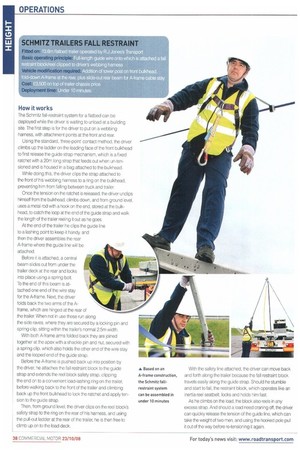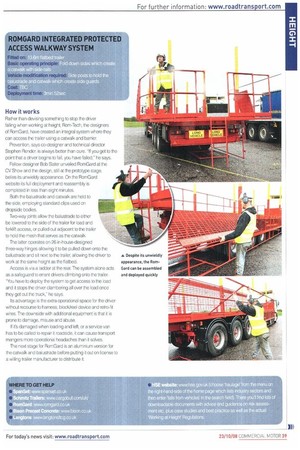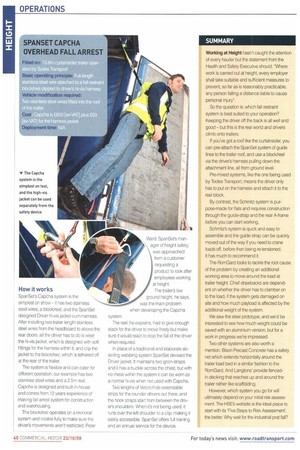Tall stor
Page 36

Page 38

Page 39

Page 40

If you've noticed an error in this article please click here to report it so we can fix it.
Words: Kevin Swallow and Brian Weatherley Images: Tom Cunningham
How can you prevent your drivers falling flat on their faces? CM looks at three safety systems to help you comply with the Working at Height regulations.
The statistics don't make for comfortable reading. According to the Health and Safety Executive. some 2,000 people are seriously injured falling from vehicles in a single year. and in 2007 alone, four of those incidents proved fatal.
Leaving aside the lost management time, pain and suffering arising from death and/or injury, there's the matter of potential prosecution and major fines for breaching health and safety laws, and, in particular, the current Working at Height regulations (see box, page 40).
On the 'Live Issues' section of its website (www.hse.gov.uk/), the USE reports that: -A recent prosecution resulted in a company being fined E12,000 following an employee's fatal fall from a trailer." Something to focus any transport manager's mind...
Along with construction, the road haulage industry has an unenviable reputation when it comes to falls from height. A fact that's doubly ironic considering how often drivers are required to climb on to a truck or trailer when delivering to construction sites.
As operators become increasingly aware of the issue of working at height, they are looking to fit equipment which can help prevent vehicle-related falls. CM has been looking at three such systems currently available on the market as part of a special H&S test.
Two of them, offered by Schmitz Trailers and SpanSet, are classic fall restraint systems, which are designed to 'catch' a driver should they trip and start to fall off a truck. The third, from RomGard, adopts a different approach, providing a catwalk and barrier, which extends around the trailer's load bed, and protects the driver from the danger of falling.
How it works
The Schmitz fall-restraint system for a flatbed can be deployed while the driver is waiting to unload at a building site. The first step is for the driver to put on a webbing harness, with attachment points at the front and rear.
Using the standard, 'three-point' contact method, the driver climbs up the ladder on the leading face of the front bulkhead to first release the guide strap mechanism, which is a fixed ratchet with a 2Orn long strap that feeds out when un-tensioned and is housed in a bag attached to the bulkhead.
While doing this, the driver clips the strap attached to the front of his webbing harness to a ring on the bulkhead, preventing him from falling between truck and trailer.
Once the tension on the ratchet is released, the driver unclips himself from the bulkhead, climbs down, and from ground level, uses a metal rod with a hook on the end, stored at the bulkhead, to catch the loop at the end of the guide strap and walk the length of the trailer reeling it out as he goes.
At the end of the trailer he clips the guide line to a lashing point to keep it handy, and then the driver assembles the rear A-frame where the guide line will be attached.
Before it is attached, a central beam slides out from under the trailer deck at the rear and locks into place using a spring bolt. To the end of this beam is attached one end of the wire stay for the A-frame. Next, the driver folds back the two arms of the Aframe, which are hinged at the rear of the trailer. When not in use these run along the side raves, where they are secured by a locking pin and spring clip, sitting within the trailer's normal 2.5m width.
With both A-frame arms folded back they are joined together at the apex with a shackle pin and nut, secured with a spring clip, which also holds the other end of the wire stay and the looped end of the guide strap.
Before the A-frame is pushed back up into position by the driver, he attaches the fall restraint block to the guide strap and extends the reel block safety strap, clipping the end on to a convenient load-lashing ring on the trailer, before walking back to the front of the trailer and climbing back up the front bulkhead to lock the ratchet and apply tension to the guide strap.
Then, from ground level, the driver clips on the reel block's safety strap to the ring on the rear of his harness, and using the pull-out ladder at the rear of the trailer, he is then free to climb up on to the load deck. With the safety line attached, the driver can move back and forth along the trailer because the fall restraint block travels easily along the guide strap. Should he stumble and start to fall, the restraint block, which operates like an inertia reel seatbelt, locks and holds him fast.
As he climbs on the load, the block also reels in any excess strap. And should a load need craning off, the driver can quickly release the tension of the guide line, which can take the weight of two men, and using the hooked pole pull it out of the way before re-tensioning it again.
How it works
Rather than devising something to stop the driver failing when working at height, Rom-Tech, the designers of RomGard, have created an integral system where they can access the trailer using a catwalk and barrier.
Prevention, says co-designer and technical director Stephen Render, is always better than cure. If you get to the point that a dryer begins to fall, you have failed," he says.
Fellow designer Bob Slater unveiled RomGard at the CV Show and the design, still at the prototype stage, belies its unwieldy appearance. On the RomGard website its full deployment and reassembly is completed in less than eight minutes.
Both the balustrade and catwalk are held to the side, employing standard clips used on dropside bodies.
Two-way joints allow the balustrade to either be lowered to the side of the trailer for lead and forklift access, or pulled out adjacent to the trailer to hold the mesh that serves as the catwalk.
The latter operates on 26 in-house-designed three-way hinges allowing it to be pulled down onto the balustrade and sit next to the trailer, allowing the driver to work at the same height as the flatbed.
Access is via a ladder at the rear. The system alone acts as a safeguard to errant drivers climbing onto the trailer. 'You have to deploy the system to get access to the load and it stops the driver clambering all over the load once they get out the truck,'' he says.
Its advantage is the extra operational space for the driver without recourse to harness, block/reel device and retro-fit wires. The downside with additional equipment is that it is prone to damage, misuse and abuse.
If it's damaged when loading and left, or a service van has to be called to repair it roadside, it can cause transport mangers more operational headaches than it solves.
The next stage for RomGard is an aluminium version for the catwalk and balustrade before putting it out on license to a willing trailer manufacturer to distribute lt.
How it works
SpanSets Capcha system is the simplest on show it has two stainless steel wires, a block/reel, and the SpanSet designed Driver hi-vis jacket-cum-harness. After installing two trailer length stainless steel wires from the headboard to above the rear doors, all the driver has to do is wear the hi-vis jacket, which is designed with soft fittings for the harness within it, and clip the jacket to the block/reel, which is tethered off at the rear of the trailer.
The system is flexible and can cater for different operation; our example has two stainless steel wires and a 2.5m reel. Capcha is designed and built in-house and comes from 12 years experience of making fall arrest system for construction and warehousing.
The block/reel operates on a monorail system and rotates fully to make sure the driver's movements aren't restricted. Peter Ward, SpanSet's man ager of height safety, was approached from a customer requesting a product to look after employees working at height.
The trailer's low ground height, he says, was the main problem when developing the Capcha System.
The reel, he explains, had to give enough slack for the driver to move freely but make sure it would react to stop the fall of the driver when required.
In place of a traditional and elaborate abseiling webbing system SpanSet devised the Driver jacket. It maintains two groin straps and it has a buckle across the chest, but with no metal within the system it can be worn as a normal hi-vis when not used with Capcha.
Two lengths of Velcro hide extendable strips for the rounder drivers out there, and the hook straps start from between the driver's shoulders. When it's not being used, it runs over the left shoulder to a clip, making it easily accessible. SpanSet offers full training and an annual service for the device.








































































































































































